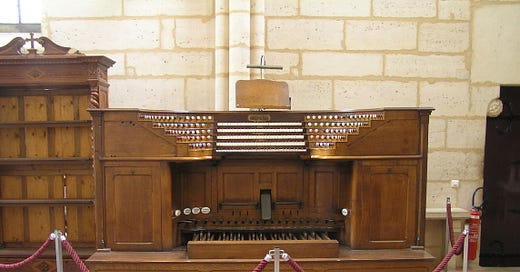The reconstruction of the Notre-Dame organ nears completion
Although the focus on Paris at present is the Olympic Games in parallel there is also the race to complete the rebuilding of Notre-Dame by the end of the year. There are many fine organs in Paris, details of which can be found on The Organs of Paris website. This site provides a history and specification of almost 300 organs in the city. Two organs dominate any history and discussion of Parisian organs, namely Notre-Dame and St. Sulpice. This is not just because of the size of the instruments but because of the associated legacy of the organists associated with them over periods of many years; Vierne and Cochereau at Notre-Dame and Widor, Dupré and Roth at St. Sulpice.
The console of the Notre-Dame organ at the time of Vierne
The two organs are very different from each other. The organ in St. Sulpice is very much the organ as built in 1862 whereas both Vierne and Cochereau were responsible for some major changes to the organ over the last century. There is an excellent thesis entitled The grand organs of Notre -Dame and Saint -Sulpice, Paris: The “Magna Opera” of Aristide Cavaillé-Coll and a critical comparison of their alterations” by Joby Ray Bell, published in 2002. This includes a side-by-side comparison of the specifications of the two instruments. (NB There is a fee to download the thesis). The differences in the spacial architecture of the churches and the placement of the instruments in their casework also make a significant difference to the impact on a congregation.
I can still recall hearing Sophie-Véronique Cauchefer-Choplin, one of the current titular organists, giving an improvisation which ended in a massive complex chord which seemed to last forever. As the sound died away I realized that having played that chord she had then played the same chord in a quiet Recit, with the result that the chord hung in the air of St. Sulpice for probably 20 seconds or more. Stunning musicianship.
In 2010 I had the privilege of being up in the tribune when D’Arcy Trinkwon was giving a recital. Sitting with my back to the organ casework I could feel the power of the instrument going through my back but also realized that the organist has absolutely no idea of what the sound picture will be for the listeners below in the nave. The photograph at the top of this column is of the console that Vierne would have played, now on display in the cathedral. (At least it was at the time.)
There is a fascinating video now available in which the Finnish organist Henrik Heikkinen provides a very detailed analysis of the Notre-Dame organ based on a sample set of the 2012 specification. The video lasts 80 minutes. It is a tour-de-force of analysis. The commentary is in Finnish with English subtitles which occasionally offer unusual spellings.
One of the many miracles of the fire that engulfed the cathedral in 2019 was that the organ escaped with no structural damage but required to be completely disassembled and cleaned. Sadly the Choir organ was very badly damaged. There is a good interview with Olivier Latry on Vox Humana dating from 2021 which provides an insight into both the work of reconstruction and also the musical life of Notre-Dame, including the fact that the organ rota amongst the four titular organists is planned three years in advance!
I should add that there is a biographical profile of Olivier Latry recently released by Dr. Butz Verlag. I will be publishing a review of this book next month.
I was delighted to see a video on YouTube recently which was a short news item from the French television channel TF1 about the progress being made on the organ restoration. The console is back in position and working! There is a longer 20 minute documentary (dating from 2023) on the progress of the work, of which there is a short summary and a link to the documentary on YouTube.
From the news item and this recent video on the overall progress of reconstruction of the cathedral, it looks entirely possible that the organ will indeed be back in action by the end of the year. It will be very warmly welcomed by the global community of organists.




